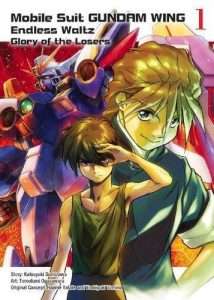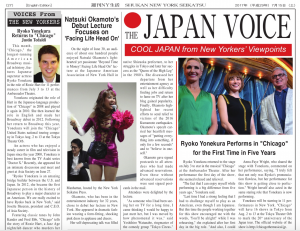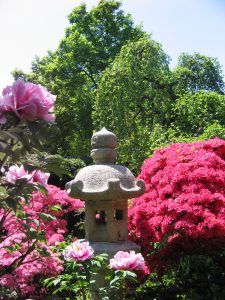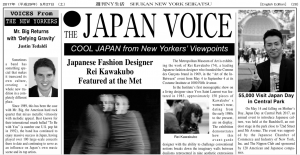JQ Magazine: Manga Review — ‘She and Her Cat’ and ‘Mobile Suit Gundam Wing: Endless Waltz — Glory of the Losers’
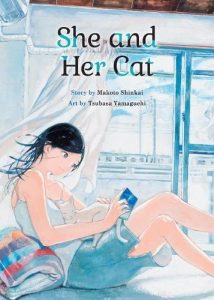
“In She and Her Cat, Shinkai does what he does best, using carefully curated imagery to set a somber tone that soothes readers into a quiet, meditative headspace.” (Vertical Comics)
By Preston Hatfield (Yamanashi–ken, 2009-10) for JQ magazine. Preston received a BA in English literature with an emphasis in creative writing and a minor in Japanese at the University of California, Davis. After spending an amazing year on JET in Yamanashi, he spent a year writing and interning with book publishing companies in New York. He currently lives in Cupertino, where he continues to cover local Japan–related stories for JQ.
This season, Vertical Comics releases two notable titles. The first is She and Her Cat, a story by acclaimed animator Makoto Shinkai, the mastermind behind 5 Centimeters Per Second and Your Name. The second is Mobile Suit Gundam Wing: Endless Waltz — Glory of the Losers, a multi-volume adventure starring everyone’s favorite fighting mecha. While very different in style, pacing, and subject matter, each title has a lot to offer its readers.
In She and Her Cat, Shinkai does what he does best, using carefully curated imagery to set a somber tone that soothes readers into a quiet, meditative headspace. From there he proceeds to unfold an understated vignette that explores adult depression. This is a timely story, our considering society’s gradual willingness to speak openly about depression and mental health more broadly.
Shinkai’s protagonist, Miyu, is a sympathetic introvert who has a hard time asking for or accepting help from others, and she is also her own antagonist, a fact that will likely resonate with readers who have battled depression. One unique feature about this story, which is also at times strained, is that it is told from the perspective of the protagonist’s cat, Chobi. While some readers may feel that Shinkai could have done more with this story, it is nonetheless well told and tactfully, intelligently handled.
By contrast, Glory of the Losers delivers action, explosions, and braggadocio. Based on creator Yoshiyuki Tomino’s classic 1970s giant robot series, the story follows a common trope: In a post-apocalyptic world, humans have broken off into different factions to colonize other planets. But when a central military agency begins annexing free colonies, a small resistance rises in the name of freedom to end their tyranny. This is an enjoyable underdog story that may have particular appeal to middle and high school students.
For more information, visit www.vertical-inc.com.
JQ Magazine: Nippon in New York — Bob James, Liberty City Anime Con, PLAY NYC
By JQ magazine editor Justin Tedaldi (CIR Kobe–shi, 2001-02). Justin has written about Japanese arts and entertainment for JETAA since 2005. For more of his articles, click here.
In the dog days of summer, it’s best to escape the heat in a place that’s cozy and cool. For those into Japan-related cultural events, this month offers a diverse selection of film premieres and live music—all in the comfort of indoor air conditioning.
This month’s highlights include:
Aug. 15-20, 8:00 p.m. and 10:30 p.m.
Bob James feat. special guests
Blue Note Jazz Club, 131 West Third Street
$20, $35
The career of multi-Grammy winner Bob James is long, varied and continues to evolve at every turn as he continues to captivate audiences throughout the world for more than 50 years, 58 albums, and innumerable awards. While James is recognized as one of the progenitors of smooth jazz, his music has also had a profound effect on the history of hip-hop, having been sampled frequently since the early days of the genre. A longtime star in Japan, he has recorded a piano duet album with Keiko Matsui, and worked with Seiko Matsuda as a guest vocalist on “Put Our Hearts Together,” written by James and his daughter Hilary in response to the Great East Japan Earthquake of 2011. Joining Bob and his special guests for the week’s sets are trumpeter Randy Brecker on Aug. 16.
Aug. 18-20, various times
New York Marriott Marquis, 1535 Broadway
$40-$60
The best three-day anime convention in New York City returns for its third year and features over 100 events and panels, three days of cosplay, game tournaments and anime screenings, concerts, balls and dances. This year’s special guests include Tyler Walker, Heather Walker, Chuck Huber, Aaron Roberts, Brittany Lauda, Matt Shipman, Ian Rubin, Dokudel, Michael A. Zekas, Marcus Stimac, and Reni Mimura!
Aug. 19-20, starts 10:00 a.m.
Terminal 5, 610 West 56th Street
$25
PLAY NYC is New York’s first and only dedicated games convention. The weekend will feature three floors of playable games for all consoles, PC, virtual reality and mobile devices from studios large and small and developers old and new. Games will include indie projects with some larger triple A titles. Get access to some of the biggest games coming later this year and discover many you’ve never even heard of. PLAY NYC celebrates every facet of gaming in a way that only the Big Apple can by uniting players, developers and industry pros at a games event like no other. Special guest speakers include multi-instrumentalist Zac Zinger of Japanese traditional/jazz fusion project KAI. Read More
JQ Magazine: Book Review — ‘The Seed of Hope in the Heart’
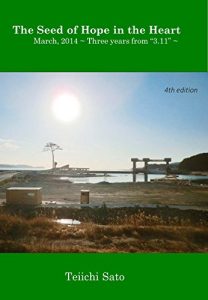
Although The Seed of Hope is a memoir of one man’s experiences during a challenging period in recent Japanese history, it is also a fascinating look into how the people of Tohoku struggled but fought to rebuild their lives. (Amazon Digital Services LLC)
By Rashaad Jorden (Yamagata–ken, 2008-10) for JQ magazine. A former head of the JETAA Philadelphia Sub–Chapter, Rashaad is a graduate of Leeds Beckett University with a master’s degree in responsible tourism management. For more on his life abroad and enthusiasm for taiko drumming, visit his blog at www.gettingpounded.wordpress.com.
There are certain moments we remember clearly as if they happened only yesterday, whether they are monumental historical events or natural disasters. But how would you tell stories centering on those moments?
Teiichi Sato has a go at it in The Seed of Hope in the Heart. In the memoir, Sato, an Iwate Prefecture seed shop owner, survives the 2011 Tohoku earthquake and tsunami but sees his beloved seed shop crumble. This plunges him into the task of rebuilding his life and livelihood amidst destruction while trying not to sink into depression and despair.
It all started with the disaster that struck on March 11, which didn’t actually come out of the blue. Sato explains that after a strong earthquake hit the Kesen area two days prior, a tsunami advisory was issued, which wasn’t really cause for a cause for concern as “weak” tsunami advisories were frequent around Rikuzentaka (where Sato lived).
But obviously, it should have been as for much of Tohoku, the world changed starting on 2:46 p.m. on March 11. Sato spends much of the early chapters detailing not only his perspective of the earthquake, but more dramatically his escape from the oncoming tsunami. While reading The Seed of Hope, you get the sense of being transported into a movie as it contains no shortage of drama as Rikuzentaka’s citizens make a desperate dash to find shelter—some of whom aren’t able to do so successfully.
JQ Magazine: Manga Review — ‘Kitaro and the Great Tanuki War’

“The Great Tanuki War stands apart from the other Kitaro volumes because in this adventure, the stakes are higher than anything you’ve ever seen.” (Drawn and Quarterly)
By Julio Perez Jr. (Kyoto-shi, 2011-13) for JQ magazine. A bibliophile, writer, translator, and graduate from Columbia University, Julio currently keeps the lights on by working at JTB USA while writing freelance in New York. Follow his enthusiasm for Japan, literature, and comic books on his blog and Twitter @brittlejules.
A haunted house built on an ancient burial ground? That’s minor league. How about an entire nation built above an army of human-hating yokai who command a catfish large enough to cause earthquakes?
Shigeru Mizuki’s Kitaro and The Great Tanuki War is a manga volume that tells an epic tale pitting the titular character, Kitaro, against an army of tanuki and their powerful yokai allies. There are also a few bonus stories with Kitaro’s usual one-shot adventures. You may already be familiar with Mizuki’s famous character, but if you are not, you can brush up on his origin story featured in the first volume, The Birth of Kitaro, which JQ reviewed last year here.
This marks the third volume in the English collection of Kitaro stories published by the fine folks at Drawn and Quarterly. One of our very own JET alums, Zack Davisson (Nara-ken, 2001-04; Osaka-shi, 2004-06), has been doing his part to put Shigeru Mizuki’s timeless work on the map in the English-speaking world. He has served as translator for these Kitaro stories and also for Mizuki’s colossal four-volume manga history of the Showa period. Zack is a yokai expert in his own right and you can find out more about his career and JET experience in our vintage JQ interview with him.
As many consumers of Japanese media may already be aware, yokai are strange creatures or phenomena that originate in Japan and have become widely popular globally. Kitaro is a unique yokai who solves mysteries and fights for humans. The conflict between humans and yokai is often an issue of tension for him as he straddles both sides, but this conflict takes center stage in The Great Tanuki War, when an army of tanuki escape from their underground dwelling beneath the island of Shikoku (shout-out to our Shikoku JET alums!), to wage a war on the human residents of Japan.
Justin’s Japan: Ryoko Yonekura Returns to ‘Chicago’
By JQ magazine editor Justin Tedaldi (CIR Kobe-shi, 2001-02) for Shukan NY Seikatsu. Justin has written about Japanese arts and entertainment for JETAA since 2005. For more of his articles, click here.
This month, “Chicago,” the longest-running American Broadway musical in history, features Japanese superstar actress Ryoko Yonekura in the role of Roxie Hart for 11 performances from July 3-13 at the Ambassador Theatre.
Yonekura originated the role of Hart in the Japanese-language production of “Chicago” in 2008 and played it again in 2010. She then learned the role in English and made her Broadway debut in 2012. Following her return to Broadway this year, Yonekura will join the “Chicago” U.S. national touring company in Tokyo August 2-13 at the Tokyu Theater Orb.
An actress who has enjoyed a steady career in film and television in Japan since the year 2000, Yonekura is best known from the TV Asahi series “Doctor X.” Recently, she appeared for an intimate discussion and meet and greet at Asia Society on June 27.
“Ryoko Yonekura is an amazing bridge builder between the U.S. and Japan. In 2012, she became the first Japanese person in the history of Broadway to play a major character as an American. We are really excited to have Ryoko back in New York,” said Josette Sheeran, president and CEO of Asia Society.
Featuring classic tunes by John Kander and Fred Ebb, “Chicago” tells the story of Roxie Hart, a Jazz age nightclub dancer who murders her lover after an argument, and the media sensationalism that follows. Originally produced for Broadway in 1975 and revived in 1996, the show won six Tony Awards the following year, and the 2002 film adaptation starring Reneè Zellweger, Catherine Zeta-Jones and Richard Gere won Best Picture at the Academy Awards. For tickets, visit www.chicagothemusical.com.
JQ Magazine: Film Review — JAPAN CUTS 2017 at Japan Society

Neko Atsume House, starring Atsushi Ito and an army of kitties, makes its East Coast premiere at Japan Society July 16.
(Neko Atsume House © 2017 Hit-Point:Neko Atsume House Production Committee
By Lyle Sylvander (Yokohama-shi, 2001-02) for JQ magazine. Lyle has completed a master’s program at the School of International and Public Affairs at Columbia University and has been writing for the JET Alumni Association of New York since 2004. He is also the goalkeeper for FC Japan, a New York City-based soccer team.
The 11th edition of JAPAN CUTS, the Japan Society of New York’s extensive showcase of new Japanese cinema, premieres tomorrow (July 13) for 11 days of unique programming, special guests, and the chance to see exclusive North American releases. This year’s lineup—29 films in all—demonstrates the wide variety of Japan’s contemporary cinematic space. The programming runs the gamut from documentaries to shoestring independents, old classics and mainstream blockbusters. A handful of films were made available for JQ press screenings; here are some notable selections:
Neko Atsume House (July 16, 12:00 p.m.): Based on a popular smartphone game, this film deals with writer’s block in a most unique way. When the novelist-protagonist Sakumoto-san (Atsushi Ito) finds himself faced with his profession’s most dreaded dilemma, he accepts an assignment to write a series of horror novels—a major step backward for this once-celebrated author. In order to solve his predicament, he adopts the old cliché of secluding himself in a country house for creative inspiration. What follows is a thoroughly unexpected delight of a movie as he makes friends with a multitude of friendly felines with whom he bonds.
At the Terrace (July 16, 6:45 p.m.): Kenji Yamauchi adapts his play for the screen, in what can best be described as a Japanese Who’s Afraid of Virginia Woolf? This dialogue-heavy film finds a group of guests drinking into the night. As the alcohol makes its way through their systems, the characters let down their guard and inhibitions and make confrontational and incriminating accusations against one another. The veneer of civility gradually dissipates until the carnal desires and petty jealousies take over the proceedings. In the process, Yamauchi skewers the pretensions of Japan’s professional and bourgeois class.
Haruneko (July 16, 8:45 p.m.): Dealing with the Japanese fascination with death is first-time director Soro Hakimoto’s Haruneko, a tale set at a forest café where people come to die. In some ways, the setting reminds one of the infamous “suicide forest” at the base of Mt. Fuji, another place for a similar purpose. Unlike that real location, Hakimoto creates an ambience that can only be described as “melancholy mysticism” as the café manager, young boy and an old woman guide their visitors into the deep woods to dissolve into the ether. This film debut serves as a harbinger of great things to come from Hakimoto, who establishes himself as Japan’s answer to the great Thai director Apichatpong Weerasethakul (Tropical Malady, Uncle Boonmee Who Can Recall his Past Lives).
JQ Magazine: Nippon in New York — Ghibli Fest, JAPAN CUTS, One OK Rock
By JQ magazine editor Justin Tedaldi (CIR Kobe–shi, 2001-02). Justin has written about Japanese arts and entertainment for JETAA since 2005. For more of his articles, click here.
Before and after the outdoor fireworks, enjoy some summer events in the cool indoors, whether it’s catching one of the dozens of films premiering at Japan Society’s annual festival, or enjoying anything from interpretative theater to the latest rock sensation.
This month’s highlights include:
June 30-July 2
The Club (La MaMa), 74A East 4th Street
$20-$100
Celebrated for her captivating work with the Martha Graham Dance Company, dancer/choreographer Miki Orihara premieres the second incarnation of her multi-media work, In the Box (ITB). Directed by theatrical visual-effects specialist Hiroyuki Nishiyama, this new experimental dance-theater piece features performances by Bessie Award winner Orihara with original music by best-selling Sony Music artist Senri Oe.
Following the 2015 Using cutting edge animations and projections from Japan, In the Box 2 (ITB2) juxtaposes three-dimensional sounds and images with the flesh and bones of a dancer and her moving shadow. ITB2 follows the 2015 premiere of ITB which explored the paradox of “Where Technology Meets the Body” inspired by Schrödinger‘s cat (quantum mechanics). ITB 2 picks up where its predecessor left off and opens the book of our lives in a paradoxical nature. “ITB2 explores human nature by mixing the human body with technology,” explains Orihara. “Audiences will experience entirely new sensations!” Using a streamlined technology of sensor system and infrared camera, audiences can enjoy the dancer’s motions and visual expressions through streamlined technology including CG, infrared cameras, and three-dimensional audio.
Wednesday, July 4-5
Village East Cinema, 189 Second Avenue
$15
Part of this year’s Studio Ghibli Fest! Perfect for audiences of all ages, PONYO centers on the friendship between five-year-old Sosuke and a magical goldfish name Ponyo, the young daughter of a sorcerer father and a sea-goddess mother. After a chance encounter, Ponyo yearns to become a human so she can be with Sosuke. Hayao Miyazaki’s tale is a beautiful combination of unbridled imagination, visual wonder and tender love, humor, and devotion from the emotional heart of the film. The July 4 screening will be presented in Japanese with English subtitles.
July 13-23
Japan Society, 333 East 47th Street
Most films $14/$11 seniors and students, $10 members
Now in its 11th year, North America’s largest festival of new Japanese cinema returns to serve up a slice of the best and boldest titles from Japan never before seen in NYC with special guest filmmakers and stars, post-screening Q&As, parties and much more. Boasting a thrilling slate of epic blockbusters, shoestring independents, radical documentaries, mind-bending avant-garde, newly-restored classics, and breathtaking animation, JAPAN CUTS 2017 promises a bounty of cinematic discoveries for film fans and pop culture enthusiasts alike. For a list of this year’s special guests, click here.
JQ Magazine: Book Review — ‘25 Places in Canada Every Family Should Visit’

“This year marks Canada’s 150th anniversary, so it’s a wonderful time for families to explore the wonders of the country. You just need the right information to do so, and 25 Places serves as a worthy reference guide.” (TouchWood Editions)
By Rashaad Jorden (Yamagata–ken, 2008-10) for JQ magazine. A former head of the JETAA Philadelphia Sub–Chapter, Rashaad is a graduate of Leeds Beckett University with a master’s degree in responsible tourism management. For more on his life abroad and enthusiasm for taiko drumming, visit his blog at www.gettingpounded.wordpress.com.
Summer is almost here. With the kids out of school, it’s the perfect time to explore new places and travel as a family. But where should you go?
Those thinking about Canada should seek out Jody Robbins’ 25 Places in Canada Every Family Should Visit for ideas. Robbins, a JET alum (Tottori-ken, 1994-97) and arguably one of Canada’s most prominent travel writers, profiles locations going counterclockwise from Victoria to Yukon, from the famous (Toronto, Vancouver) to the relatively unknown (Parksville-Qualicum Beach, Avalon Peninsula).
As the book is geared towards parents, Robbins devotes plenty of space to sharing advice about how they can entertain their young ones. In addition to expounding on the requisite what to do and see activities for each destination, Robbins just as importantly lists family-friendly options for dining (“Kids will love the wood-fired bambino pizza” at Pizzeria Prima Strada in Victoria) and lodging (a highlight of the Fairmount Chateau Laurier in Ottawa is the Art Deco-style pool, which “children love parading down to in their child-size bathrobes”).
25 Places features a diverse mix of urban and nature-filled destinations (like Outaouauis), so readers will get a great sense of Canada’s varied landscapes, as well as some surprises (beaches on the Prairies? Yes, they exist) and more importantly, how to arrive prepared for them. While it’s obvious that Robbins would include information about how to get around certain places, she excels when extensively detailing how to make your camping trip a safe and wonderful experience: An entire chapter is devoted to providing readers advice about tackling and overcoming the challenges that awaits (as well as tips about what to pack and eat). Camping novices would do well to heed this helpful advice.
JQ Magazine: Philadelphia LOVEs Japan
By Therese Stephen (Iwate-ken, 1996-99) for JQ magazine.
What many people don’t know is that the City of Brotherly Love is in love with Japan, and has been since the 1876 Centennial Exhibition in Philadelphia, when the Japanese Pavilion became one of the most popular exhibits of that historic World’s Fair.
When you think of Philadelphia, you probably think of cheesesteaks, the Liberty Bell, Independence Hall or the Rocky steps at the Philadelphia Museum of Art. What you might not realize is that Philly has many ways for Japanese, and the Japanese-at-heart, to get their Japan fix for a lot less than a roundtrip ticket to Tokyo. So, whether you’re planning a quick weekend getaway or day trip this summer, or if you’re a returning Philly JET looking at your hometown with a new post-JET perspective, read on for Philly’s best Japan picks.
Let’s start with those famous Rocky steps. It’s cheesy and we know it, but everyone who visits Philly has to replay that famous Rocky Balboa moment. So once you’ve run to the top of the steps and done your obligatory fists-in-the-air-pose, head on into the Philadelphia Museum of Art (PMA) and find your way to the East Asian Galleries.
One of the most endearing and exciting things about the PMA are its period rooms. While there are plenty of rooms displaying objects on pedestals or paintings on walls, a few steps through a doorway connecting two galleries will suddenly put you in the middle of an Indian temple or the hall of a Chinese palace. Wander a little further and you’ll find Sunkaraku Tea House, the highlight of the Japanese collection in the East Asian Galleries.
Justin’s Japan: Mr. Big Returns with ‘Defying Gravity’
By JQ magazine editor Justin Tedaldi (CIR Kobe-shi, 2001-02) for Shukan NY Seikatsu. Justin has written about Japanese arts and entertainment for JETAA since 2005. For more of his articles, click here.
Sometimes a band has something special that makes it transcend its own culture, creating a whole new tradition in a completely different place.
Since 1989, this has been the case with Mr. Big, the American hard rock quartet that mixes metallic virtuosity with melodic appeal. Best known for their international smash ballad “To Be with You” (a number one pop U.S. hit in 1992), the band has continued to enjoy massive success in Japan, having played over 100 large-scale concerts there to date and continuing to serve as an influence on Japan’s own music scene and its top artists.
Mr. Big’s drummer Pat Torpey and bassist Billy Sheehan have previously performed with Japan’s all-time most successful rock group B’z (with the latter even joining them on tour); lead singer Eric Martin has recorded a successful string of “Mr. Vocalist” albums consisting of songs originally made famous by female Japanese singers; and guitarist Paul Gilbert has appeared on Japanese talk shows displaying both his tremendous guitar chops and dedicated study of the language.
In a new tradition, the U.S. will get the first taste of all-new Mr. Big material as the group launches a 13-date national tour beginning May 31, with a New York stop at B.B. King Blues Club & Grill on June 10. The tour precedes the release of the group’s ninth studio album, “Defying Gravity,” available July 7 on Frontiers Records. The new songs will presumably make their live debut at these special American gigs.
For tickets to the show and more information, visit www.bbkingblues.com and www.mrbigsite.com.
Also on June 10 at 12:00 p.m., An Intimate Afternoon of Conversation and Music with Mr. Big will take place at The Cutting Room (44 East 32nd Street), featuring a long–form interview with author and journalist Brad Tolinsk. This special event includes an opportunity for audience questions, a short acoustic performance, and a meet and greet. Tickets are $25; for more information, click here.
Justin has written about Japanese arts and entertainment since 2005. For more of his stories, visit http://jetaany.org/magazine.
JQ Magazine: Nippon in New York — AnimeNEXT, Mr. Big, ‘My Neighbor Totoro’
By JQ magazine editor Justin Tedaldi (CIR Kobe–shi, 2001-02). Justin has written about Japanese arts and entertainment for JETAA since 2005. For more of his articles, click here.
After an unusually chilly spring, it’s finally starting to feel like summer. Enjoy some seasonal events this month that celebrate the best of both fine art and pop art.
This month’s highlights include:

Courtesy of Asiasociety.org
June 1-2, 6:30 p.m.
Asia Society, 725 Park Avenue
$12, $10 students/seniors, $8 members
Highlighting some of the most exciting new voices in cinema, New York Japan CineFest presents two nights of short films by emerging Japanese and Japanese American filmmakers. Featuring 15 short films spanning drama, sci-fi, documentary and anime, the first night’s program is followed by a reception. Click here to check out Program 2 on Friday, June 2, 2017.

Courtesy of Bluenote.net
June 6-11
Blue Note Jazz Club, 131 West 3rd Street
$30-$45
Japan has produced an impressive assemblage of jazz pianists; from Toshiko Akiyoshi and Makoto Ozone to Junko Onishi. And now, well into the change of the 21st century, the pianist/composer Hiromi Uehara is the latest in that line of amazing musicians. Ever since the 2003 release of her debut album Another Mind, Hiromi has electrified audiences and critics east and west, with a creative energy that encompasses and eclipses the boundaries of jazz, classical and pop parameters; taking improvisation and composition to new heights of complexity and sophistication. These special duet performances with Colombian harpist Edmar Castañeda are sure to inject a Latin flavor to the mix.
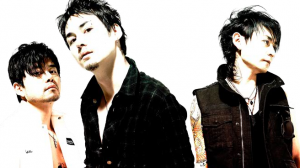
Courtesy of Okmusic.jp
June 9-11
Atlantic City Convention Center, 1 Convention Boulevard
$50-$60
The largest independently organized anime convention in the New York/New Jersey metropolitan area. AnimeNEXT features Japanese creators of anime and manga, voice actors, musical acts, artists, vendors and exhibits, events, panels, workshops, gaming, and cosplay. This year’s special guest is Oblivion Dust, a major label Japanese rock act, which reunited in 2007 following a six-year hiatus. Although they were originally largely influenced by early ’90s American grunge bands, since reuniting their music has become straight alternative rock. They stand out in the Japanese scene as most of their songs are written and sung in fluent English.
JQ Magazine: Book Review — ‘The Little Exile’
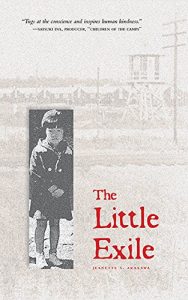
“The Little Exile reveals a world of angst, but hope in a world that has been turned upside down.” (Stone Bridge Press)
By Rashaad Jorden (Yamagata-ken, 2008-10) for JQ magazine. A former head of the JETAA Philadelphia Sub-Chapter, Rashaad is a graduate of Leeds Beckett University with a master’s degree in responsible tourism management. For more on his life abroad and enthusiasm for taiko drumming, visit his blog at www.gettingpounded.wordpress.com.
Earlier this year I explored Uprooted, an exhibition devoted to the Japanese American internment. Considering how many families were displaced following Pearl Harbor, “uprooted” is at the perfect word to describe how a lot of people’s lives were disrupted.
Uprooted also comes to mind when reading The Little Exile. Written by Jeanette Arakawa, the novel tells the story of Marie Mitsui, a Japanese American girl living in San Francisco, whose world is jolted after the events of December 7, 1941 as she and her family is forced to relocate to an internment camp in Arkansas. Based on her own life story (although some names in the book have been changed), Arakawa takes readers on a journey through the brutal challenges that many Japanese Americans faced.
At first, you might think that The Little Exile is an uneventful novel, as the first few chapters capture a seemingly carefree life that the Mitsuis enjoy (Marie has an older brother named Brian). They seem to be a typical American family—Marie’s parents run a dry cleaning shop where the whole family lives. She loves roller-skating with her friend Beverly and often spends time on the playground (She frequently wins amateur hour contests there).
However, San Francisco is not paradise for the Mitsuis—Brian learns from his father that due to “racial covenants,” the family is prohibited from buying houses in a certain neighborhood. In addition, classmates hurl racial slurs at Brian and Marie upon their arrival at the Lawton School in December 1940.
JQ Magazine: Japan Society Salutes Godzilla with Concert Spectacular

Special guests Charan-Po-Rantan and Makigami Koichi (center) performed in Godzilla Legend — Music of Akira Ifukube at Japan Society on April 28. The concert was conceived and arranged by Makoto Inoue (far left) and performed by the band Hikashu and other special guest musicians. (Ayumi Sakamoto)
By Lyle Sylvander (Yokohama–shi, 2001-02) for JQ magazine. Lyle has completed a master’s program at the School of International and Public Affairs at Columbia University and has been writing for the JET Alumni Association of New York since 2004. He is also the goalkeeper for FC Japan, a New York City–based soccer team.
On April 28, the Japan Society of New York hosted a delightfully unusual concert of Godzilla music. Yes, you read that correctly. The Japanese pop techno band Hikashu took the stage in a 90-minute intermission-less night of monster music from such iconic classics of the Godzilla canon as Gojira (a.k.a. Godzilla, King of the Monsters!) (1954), Rodan (1956), Mothra (1961), King Kong vs. Godzilla (1962), Ghidora, the Three–Headed Monster (1964), Godzilla vs. Mechagodzilla II (1993) and Godzilla vs. Destoroyah (1995). While the colossal black-green (his color fluctuates from movie to movie) lizard never made an onstage appearance, he made his presence aurally known through Hikashu’s superb performances, with narration by founding member Makoto Inoue (who also played keyboards) and special appearances by the female pop duo Charan-Po-Rantan. Adding to the fun were aural appearances by the Big G’s nemeses, Rodan, King Ghidora, King Kong and Mothra, a gigantic butterfly-like insect who was the only monster to ultimately defeat Godzilla in battle.
Inoue’s narration did more than entertain; it also provided informative commentary on the evolution of the films. As Inoue explained, Godzilla was born out of the collective Japanese fear of both large natural disasters (earthquakes, typhoons and tsunamis) and of the atomic bomb. Produced just nine years after the bombings of Hiroshima and Nagasaki and one year after the U.S. testing of a hydrogen bomb contaminated a Japanese fishing vessel, the original Japanese film is a dark and somber affair. For years, the only available version in North America was a re-edited film that mixed a new English-language narrative with the Japanese monster footage—that film starred Raymond Burr and downplayed the ominous sadness.
JQ Magazine: Nippon in New York — George Takei, Tokyo x Brooklyn, Japan Day @ Central Park
By JQ magazine editor Justin Tedaldi (CIR Kobe-shi, 2001-02). Justin has written about Japanese arts and entertainment for JETAA since 2005. For more of his articles, click here.
As spring continues and the weather continues to warm, New Yorkers can enjoy activities all over the city both indoors and out.
This month’s highlights include:
Monday, May 1, 7:30 p.m.
BAM Howard Gilman Opera House, 30 Lafayette Avenue
$35-$75
Actor and social justice activist George Takei brings his uncanny eloquence and signature wit to BAM. In this very special evening, he shares the story of his Japanese-American family’s forced internment during World War II, a seemingly forgotten part of American history. He also takes audiences through his rise to celebrity as a sci-fi icon, his remarkable journey as social media mega power, and his passionate fight for LGBTQ rights and marriage equality in America—empowering others to beat the odds and make a difference.

Courtesy of Asiasociety.org
Wednesday, May 3, 6:30 p.m.
Monkey Business: Japan/America Writers’ Dialogue
Asia Society, 725 Park Avenue
$20, $15 students/seniors, $12 members
Join a conversation between Japanese and American writers as part of the annual PEN World Voices Festival. This year’s featured writers are award-winning novelist Jamaica Kincaid, author Brian Evenson, Japanese writer Hiroko Oyamada, and Hiromi Ito, one of the most important female voices in contemporary Japanese poetry. Each ticket includes a complimentary copy of the latest volume (#7) of Monkey Business.
Thursday, May 4, 9:00 p.m.
Rough Trade NYC, 64 North 9th Street (Brooklyn)
$15
Kikagaku Moyo (Geometric Patterns) is the musical union between five free spirits. Go Kurosawa (drums, Vocals) and Tomo Katsurada (Guitar, Vocals) formed the band in 2012 as a free artist’s collective. They met Kotsuguy (Bass) while he was recording noise from vending machines and Akira (Guitar) through their university. Ryu Kurosawa had been studying Sitar in India, upon returning home he found the perfect outlet for his practice. Since 2013 the band has released two full lengths, an EP, and several singles. They have toured Australia, the United States, Europe and Japan extensively. Their music is a conversation—sometimes delicate and tender other times explosive, but always human and always changing. With support from Mountain Movers and Jason Spacin’ Killinger.
Thursday, May 11, 7:30 p.m.
B.B. King Blues Club & Grill, 237 West 42nd Street
$29.50-$69.50
With guitar styles ranging from rock, blues, jazz and fusion to pop and soul, Richie Kotzen has built a remarkably diverse 25-plus year career as a guitarist, singer and songwriter. A veteran of numerous groups including the Winery Dogs, Kotzen’s Japan cred is extensive: He wrote the number one song “Shine” as a member of Mr. Big, which was used as the ending theme for the anime series Hellsing, has recorded an entire album of music from the anime series Gundam, and toured as the opening act on the Japanese leg of the Rolling Stones’ 2006 tour. The Kotzen Telecaster guitar has repeatedly been the #1 selling signature model guitar for Fender Japan. This show will include selections from his new album, Salting Earth.
May 13-14
Brooklyn Expo Center, 72 Noble Street
$15-65
This all-new pop culture festival brings together two cultures, Tokyo and Brooklyn, featuring an exciting lineup of musicians, a variety of culinary favorites, innovative technology, artists and performers. The concept is to bridge the gap between Brooklyn creativity and craftsmanship and Japanese pop culture. Festival attendees experience more than just a spectacular neighborhood event, which Includes vintage anime screenings of films like Akira and Ghost in the Shell and headline performances from acts including MIYAVI, Anamanaguchi, DJ Logic (Plus Special Guests) and the Taiko Masala Thunder Drummers.
Sunday, May 14, 9:30 a.m.-4:00 p.m.
Free
Now in its eleventh year, Japan Day has won acclaim from New Yorkers from every walk of life, with Mayor Michael de Blasio calling it an eagerly anticipated cultural event on the city’s calendar. For this year’s event, organizers are planning once again to have both the Japan Run (beginning in the early morning) and the Japan Day Festival, emphasizing enjoyable activities for all ages that will deepen participants’ understanding and appreciation of Japanese culture—not to mention the food, drinks and snacks! Hosted by CNN national correspondent Sandra Endo, previous guest performers have included AKB48, Jero and Akiko Yano.
Sunday, May 28, 5:00 p.m.
Irving Plaza, 17 Irving Place
$25 GA, $95 VIP meet and greet
Generations from Exile Tribe (a.k.a. Generations) is a seven-member Japanese boy band signed to the Avex Group label Rhythm Zone. lThe group belongs to the talent agency LDH and is part of the collective “Exile Tribe,” related to pop group Exile. Generations debuted in November 2012 and is ready to make its New York debut.
Want to stay in the loop on future events? Follow Justin on Facebook and Twitter.
JQ Magazine: Book Review — ‘Japanese Garden Notes’
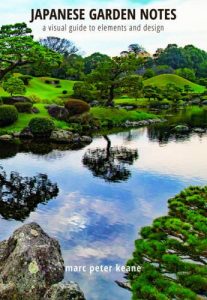
Keane is the perfect person to expound on the finer aspects of the Japanese garden. Reading Japanese Garden Notes basically transports you to a museum as the text is similar to the interpretation you’d receive from a seasoned docent. (Stone Bridge Press)
By Rashaad Jorden (Yamagata-ken, 2008-10) for JQ magazine. A former head of the JETAA Philadelphia Sub–Chapter, Rashaad is a graduate of Leeds Beckett University with a master’s degree in responsible tourism management. For more on his life abroad and enthusiasm for taiko drumming, visit his blog at www.gettingpounded.wordpress.com.
One Golden Week afternoon after exploring Okayama Castle, I decided to stroll over to nearby Kōraku-en Garden. Mainly because it was there and I wasn’t sure what else to do in Okayama. But once I stepped on the premises of the garden, a sense of serenity fell over me as did the feeling I felt like I had found a gem, as well as a place where time stood still.
What is the world of these elegant locales like? Landscape architect and author Marc Peter Keane answers that question and more in Japanese Garden Notes: A Visual Guide to Elements and Design.
It’s clear that Keane, a garden designer and Kyoto resident for roughly twenty years, will explain “what makes a Japanese garden feel the way it does” largely through photographs. But what will readers be looking at? Pretty much Japanese Gardens 101, as each chapter bears the name of a concept or feature present in Japanese gardens like meandering paths, arbor bridges, streams, and more. A phrase further describing the main concept appears prior to the explanations in each chapter and those descriptions run the gamut from the profound (“A meandering path is full of surprises”) to the explanatory regarding the appearance of the garden (“Linking a distant part of the garden with the foreground”) to the borderline hilarious (“Japan is wet, thus the dry garden.”).

